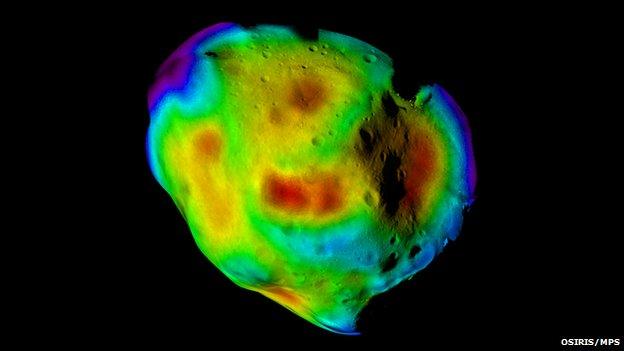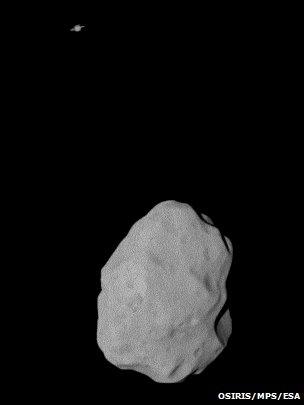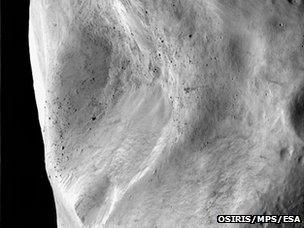A fleeting encounter with an 'inbetweener'
- Published
- comments

Modelling the gravity field of Lutetia may help solve the puzzle over its high density
There's a problem with the one-off flyby of a planet or an asteroid, and that is you can't go back and do it again - obviously!
But it's a frustration because you're bound to discover stuff in the flyby that merely raises more questions - questions you might be able to answer if you could only go around and do a second visit.
Scientists find themselves in precisely this situation now with the Asteroid Lutetia.
Europe's Rosetta probe, external whizzed past the giant rock in the summer of 2010 on its way to a comet in 2014.
At the time, it was the biggest asteroid visited by a spacecraft, and some spectacular imagery was obtained by Holger Sierks and his team, external using the Optical, Spectroscopic, and Infrared Remote Imaging System (Osiris) on Rosetta.
When the researchers did their analysis of the data, they made a tantalising discovery.
Colin Snodgrass: "Classifying Lutetia is far from easy"
They found that this 121km-long rock was some 1.7 million billion tonnes in mass.
That was actually slightly less than they had anticipated, but with the refined volume they were able also to work out from the flyby, it could be determined that Lutetia had a very high density - one of the highest densities of any known asteroid: 3.4 tonnes per cubic metre.
How come? Well, one exciting possibility is that Lutetia was once partially molten, and although you can't see any obvious evidence for it at the surface, it could have an interior volume containing significant quantities of iron.
To form such a "core", Lutetia would have had to melt as a result of heat released by radioactive isotopes in its rocks. The dense iron would then have sunk to the centre, with the rocky material left floating on top.

The Osiris camera system caught Saturn in the background of one image
This is the process of differentiation and it is something evident in the fully formed terrestrial planets like Earth and Mercury.
How far such a process could have progressed on Lutetia is uncertain.
The spacecraft's data indicates the asteroid has a very primitive surface - rather like the chondritic meteorites that are sometimes picked up on Earth and which are assumed to have come from bodies that experienced no melting or differentiation.
It is a view being challenged by Dr Ben Weiss from the Massachusetts Institute of Technology, US.
He has argued that many of the large asteroids out there could have reached a stage of partial melting - even ones that at the surface appear to be unchanged.
He bases that claim on the number of chondritic meteorites that have clearly been magnetised. That suggests these rocks have been near a molten iron core.
"If you do the thermal models, these large asteroids would melt from the inside out because they have this radiogenic heating," he explained.
"The outside is always at space temperatures, and so you always get an un-melted outside. It might be really thin, but we've shown it can also be quite thick. So, we've proposed this idea that there might be asteroids in between un-melted and fully melted - a whole spectrum," Dr Weiss told me.
"It hints at a hidden diversity in the asteroid belt where there may be all kinds of bodies with interesting interiors that are obscured by their relic chondritic surfaces."

Close-up, it's possible to see large boulders
But how do you prove Lutetia took the path to core formation? Rosetta is long gone for its appointment with Comet 67P/Churyumov-Gerasimenko, and there is no plan currently for another spacecraft to visit Lutetia to follow up these ideas.
Well, Dr Jean-Baptiste Vincent, from the Max-Planck Institute for Solar System Research (MPS), Germany, is poring over Rosetta's high-resolution pictures of Lutetia.
The giant rock is covered in a thick blanket of debris built from millions of years of bombardment by smaller bodies.
In places, you can see where this material has slipped, particularly down the sides of crater walls.
Using knowledge of how the flow of materials in landslides on Earth depends on gravity, Dr Vincent is examining the slopes across the surface of Lutetia to try to measure the local gravity.
Models using either a constant density, or a differentiated internal structure, will produce different local slopes which can be compared with the observed landslides.
"We don't know what is the gravity field of this asteroid; we only know its mass and its density," Dr Vincent said.

What might have been: Lutetia started out on the road to becoming a planet...
"So, what we're trying to do here is run some simulations of what would be the gravity field if Lutetia had different layers of different densities. And then we see if those correlate with some of the morphologic features we observe, such as avalanches or the strange shape of some very big craters."
The colourful image at the top of this page is a product of one of Dr Vincent's simulations. It illustrates the gravity field of Lutetia assuming it was a differentiated body with a porous crust, a silicate un-molten mantle and a rocky core enriched in iron.
The colours indicate the strength of the gravity field at the surface of the asteroid, with red representing the strongest values and blue the weakest.
In this simulation, loose material on the surface of Lutetia would move preferentially from blue areas to red ones during a landslide.
The research still has some way to go before coming to any conclusions.
But it makes you wonder how many other potential "inbetweeners" might be out there still in the asteroid belt.
"There are the really big objects like Ceres and Vesta, but down at Lutetia's size there are 200 objects or so," observed Dr Colin Snodgrass, also of MPS.
"And that's now. In the past, there were likely very many more that didn't survive, were destroyed or got thrown out of the Solar System as the large planets migrated and disturbed everything."
- Published10 July 2010